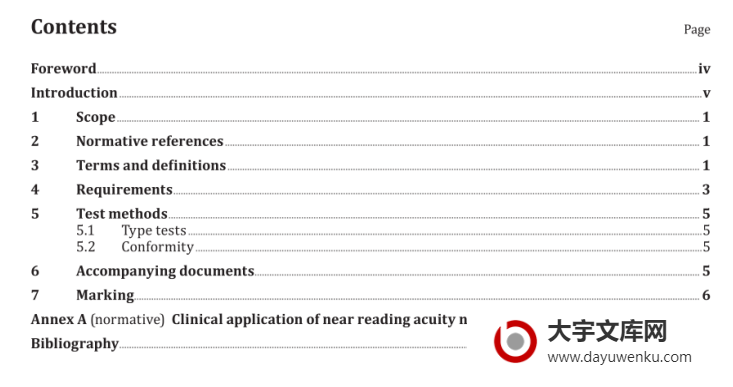ISO 7921:2024 pdf download - Ophthalmic optics and instruments - Near reading charts 眼科光学和仪器 - 近读数图表
ISO 7921:2024 pdf download Ophthalmic optics and instruments - Near reading charts.
眼科光学和仪器 - 近读数图表
This document applies to printed, projected, and electronic displays of high-contrast text that are designed for assessment and measurement of near reading acuity under photopic conditions.
The definitions and requirements of this document apply to the Latin alphabet.
本文档适用于高对比度文本的印刷、投影和电子显示,用于评估和测量在感光条件下的近阅读敏锐度。
本文档的定义和要求适用于拉丁字母。
This document provides the terms,definitions,and requirements for standardized charts for the assessment of near reading acuity.Reading is a complex visual task that involves more than the mere identification orrecognition of individual letters,symbols,or other optotypes.The charts used to assess near reading acuityare intended for the practical purpose of demonstrating whether or not a patient can read sentences orparagraphs of text of a particular size.This document is not meant to replace or supplant standards forvisual acuity charts for research or for basic clinical assessments,such as visual acuity measurementsbefore and after cataract surgery.
A patient's reading ability can be labelled using terms such as "difficult"or "easy",or "with errors"or"fluent"or "error-free"。Proper assessment of reading ability requires the use of text that is appropriate forthe patient,for example,based on the patient's age or educational level.However,the actual determinationof a patient's near reading acuity based on these and possibly other factors involves clinical evaluation thatis beyond the scope of this document.
This document bases the nominal near reading acuity grade on values given as the logarithm of reading acuitydetermination (logRAD)。LogRAD is similar to the logarithm of minimum angle of resolution (logMAR),usedin standard visual acuity testing,in that both are based on the angular size of the test target at a particularviewing distance.However,logRAD specifically depends on the height of lowercase letters,which occurmore frequently than uppercase letters,numbers,and symbols in typical text.On the other hand,logMAR isdetermined by the width of an individual line or the size of a gap.For ease of clinical application,equivalentnear reading acuity grades are provided for several common recording notations,including decimal readingacuity,M size,N size,and reduced Snellen fractions.
This document allows for the use of any typeface that is similar in appearance to either of two commontypefaces:Times New Roman,a typeface with serifs,which is widely used for printed text;and Helvetica,a sans serif typeface,which is commonly used for both printed charts and electronic displays,such ascomputer monitors,laptops,and smartphones.
This document applies to the Latin alphabet.It can also apply to similar alphabets,such as Greek and Cyrillic,that can be expressed with typefaces similar to Times New Roman or Helvetica.For other writing systems,such as Arabic,Chinese,Hebrew,Japanese,and Korean,this document can be used as a reference,especiallyfor researchers who wish to demonstrate equivalence of near reading charts using those writing systemswith charts using the Latin alphabet.

下载信息
进入下载地址列表









